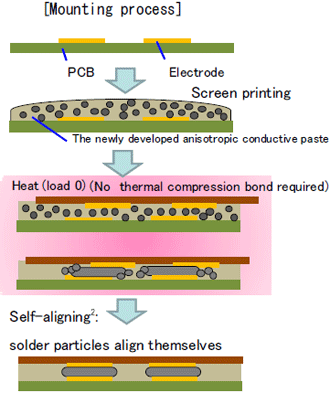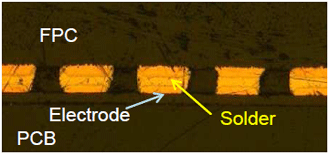―Simply adding heat makes the solder particles self-assembly to the electrodes to form a metallic bond―
|
◆ |
High-speed transmission / high allowable current securing high adhesion and high reliability |
|
◆ |
Enables thin connection, fine pitch connection, bonding to difficult-to-connect copper electrodes |
SEKISUI CHEMICAL CO., LTD. (President: Naofumi Negishi, hereinafter called
"Sekisui Chemical")’s High Performance Plastics Company (President:
Keita Kato) has developed an anisotropic conductive paste where the solder particles
self-assembly to electrodes simply through heating to form a metallic bond.
Connection is possible now simply through heating, eliminating the need for thermal compression bond of the electronic device PCBs, FPCs (flexible printed circuits), electronic parts and so on. We are exploring applications in place of connectors used for bonding or solder connections.
|
|
1. Background to the Development
The High Performance Plastics Company has "Chemical Solution" as
its slogan and is supplying highly functional plastic processed products and
raw plastic materials globally, primarily in the four strategic fields of electronics,
automobiles and transportation, buildings infrastructures and life sciences.
It
owns its proprietary microparticle technology and resin compounding technology
in the electronics field, and is expanding its business primarily for FPDs (Flat
Panel Displays). Its aim has been to use these technologies to enter into the
implementation sector with new materials.
2. The Development Process
With the increasingly high functionality of mobile devices such as smartphones
and tablets in recent times, there is a demand for high-speed transmissions
and high allowable current as well as for more compact, slimmer and lighter
devices, leading to requirements for greater accuracy and reliability.
Previously
thermal compression bond was needed to connect PCBs and FPCs, requiring the
adoption of special equipment and devices. By developing this new anisotropic
conductive paste not requiring thermal compression bond, connection is made
possible just with ordinary heating, making possible the proposal of new processes
/ production technologies.
3. Overview / characteristics of the new anisotropic conductive paste
Structure / functions
The anisotropic conductive paste developed here is a resin connection material in paste form with solder particles evenly distributed in thermosetting resin. It has the function of electronically connecting electrodes of electronic parts, etc. and making them bond together.
Principle |
|
|
Paste is applied between the electrodes and then heat applied
without thermal compression bond (e.g. a reflow furnace, oven, hot
plate, spot heating) to make the solder particles self-assembly
to the electrodes, forming a metallic bond between them. The surrounding thermosetting resin will harden to form a bond. |
|
|
|
|
|
|
|
|
Note 1) Conditions: Misalignment of half or less of the width of the electrode; pitch width = approx. 150μm. Impossible for heavy parts, but FPCs present no problem. |
|
|
Note 2) Self-aligning: The solder particles will align their own position between the electrodes when self-assembling. |
|
Bond structure |
|
|
The solder exists only in the vertical space between the electrodes; the surrounding area is bonded hard by the resin. |
|
|
|
|
Technology uniqueness, specifications, characteristics
The new anisotropic conductive paste Sekisui Chemical has developed here
has made possible bonding over surfaces instead of point touch contact with
previous anisotropic conductive pastes, and as such realizes high-speed transmission
and high allowable current. The bond is made with thermosetting resin covering
the electrodes and bonded area, securing high adhesion and reliability.
This makes thin connection more possible than compared to connector bonding.
In addition, because the conductive particles do not exist outside of the vertical
space between the electrodes, finer pitch connections are possible than with
previous types of anisotropic conductive pastes.
The new anisotropic conductive paste itself functions to remove the oxidized membrane on the electrodes' surface (flux function), making bonding possible not only for gold but even for oxidizing, hard to bond copper electrodes as well.
|
|
|
|||||||||||||||||||||
|
|
|
|||||||||||||||||||||
|
|
|
|||||||||||||||||||||
|
|
(3) Mounting conditions |
|||||||||||||||||||||
|
|
|
Low temperature, immediate hardening: heating x time = 180℃ x 15 seconds to 140℃ x 2 minutes (reference scope) |
||||||||||||||||||||
4. Future developments
We expect to be able to apply this product to many part mounting and bonding
applications, replacing connectors, bonding FPCs and for rigid-flexible PCBs.
In the future, we will provide samples and through this search out applications
to meet various needs.
Our lineup also includes anisotropic conductive
pastes use with thermal compression bond devices able to form bonds with standard
evenly distributed particles or for connecting PET circuit board material, and
will demonstrate them at the JPCA Show 2014 to be held at Tokyo Big Sight from
June 4 to 6, 2014.
Sekisui Chemical will also continue to advance the high functionality of FPD devices such as mobile terminals.
Disclaimer
This press release may contain forward-looking statements. Such forward-looking statements are based on current expectations and beliefs and are subject to a number of factors and uncertainties that could cause actual results to differ materially from those expressed or implied by such statements due to changes in global economic, business, competitive market and regulatory factors.



